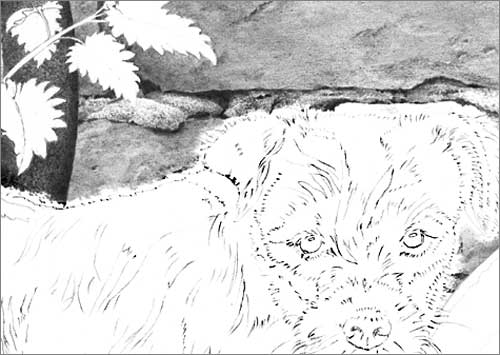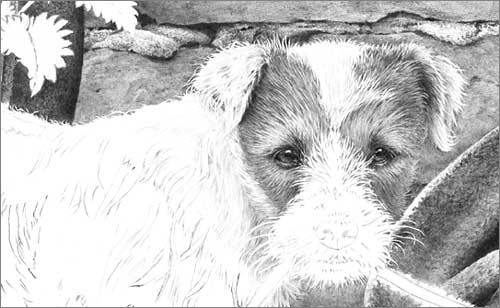NEGATIVE DRAWING
Negative drawing enables you to perform tasks easily. We previously saw:
- How we can control separation of background, midground and foreground elements.
- How we can isolate those areas we don’t yet understand.
- How Negative Drawing protect our virgin whites.
Negative drawing involves the creation (or isolation) of an element within your drawing by simply drawing around it. To return to our dog example, by completing the background first, you have an established setting in which your dog can exist. Because you are drawing this dog as a part of its world, the two will become unified and possess an enhanced feeling of reality.
RECESSION
Up until now I’ve been referring to background and foreground. But in reality our dog is more likely to be situated in the midground. So by “background” I’m really referring to the major part of the setting – that area BEHIND the dog, and not the foreground, which is on a level with and below the dog.
We will have created enough of the dog’s world to give us an understanding on the environment – a ‘feeling’ for that world. Because we cannot avoid taking that world into account as we draw, the dog will inevitably become a part of it.
In practice, you might choose to partially draw the background to get a feel for it, then to begin drawing the dog, establishing the tones required for the background around its outline. That’s OK if that appears to be the logical way to work.
LOGIC
Logic, as I explained earlier, plays a major role in this way of working. Logic in this case is mainly dictated by understanding. You draw what you understand then, when that understanding wanes, you logically move to another area of understanding. This is difficult to describe but easy to understand in practice.
Let’s take one small area again – the junction of the dog’s coat along its back with the background. If you want that topline to be obvious to the viewer you cannot draw the dog first. Without a background, you have nothing to balance your tones to. So we draw that section of the background first, right down to the dog’s back. There we have two choices – if we fully understand the outline of the dog, we can draw around the hairs along its back, leaving them pristine white. Or we can stop short of the dog and make the junction a job in its own right. This gives you all the control you need. Finally you can concentrate on the dog, engineering the tones used within the coat to make it stand out from the background – to whatever extent you wish. It’s a logical progression that puts you in control.
Below you will see that I drew the brickwork down to but short of the dog’s back. Why? Because I was immersed in brick, not hair. Now I can concentrate on defining the dog’s outline while blending new drawing back up into the brickwork – I’m thinking “hair”, not “brick”.

Brickwork stopped short of dog. Now I can concentrate on defining the dog’s outline while blending new drawing back up into the brickwork. I was thinking “brick”, now I’m thinking “hair”.

Note that I didn’t attempt to draw the dog while defining its outline. My concentration was purely on the creation of the hairs around its extremity.
CONCENTRATION
A drawing, any drawing, can be broken down and simplified in this way. If you’re drawing the wooden side of a barn, just draw wood. If grass overlaps it at the base, draw around it. You’re drawing wood – your concentration is on wood – you’re living wood! And, as a bonus, when you begin to draw grass, you’ll have full control over those negatively drawn stalks that overlap the barn door, so you can highlight them, push them into shade, or make them as dominant or subtle as you wish.
WHICH IS DOMINANT?
Where any two textures meet, ask yourself which is dominant. Which will logically control the tones of the other. If we draw the grass first, the tones used within the blades will control and limit the tones available for our barn door. If we draw the barn door first, its tonal values will control those available for the grass. Which is logically dominant from the point of view of physically drawing them? Which is easier to engineer to overcome the limitation imposed by the other? No contest, in my mind, the barn door wins on all counts. It’s so much easier to engineer the blades of grass to stand out from, or blend into, the barn door.
As a bonus, Negative Drawing prevents you from polluting the virgin white within your drawing. Erasing graphite from a spot that should be a pristine white highlight will rarely achieve a good result.